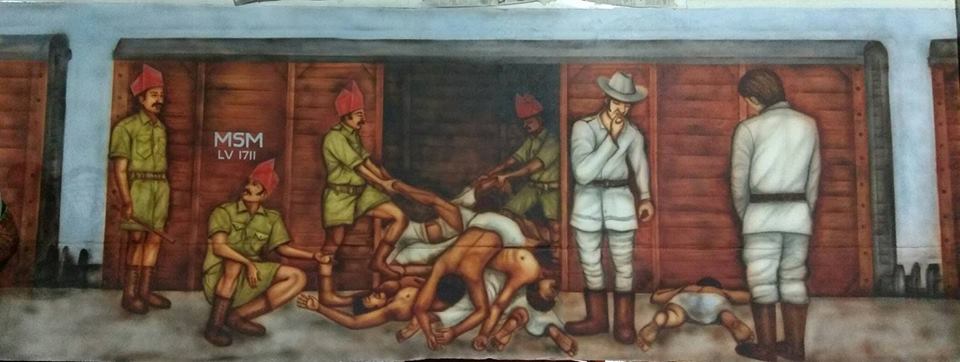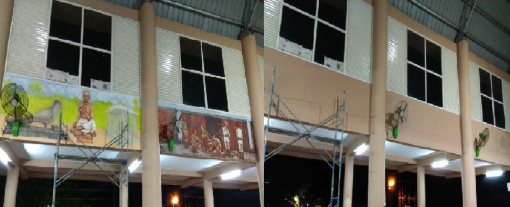
On November 10, an acrylic painting of the 1921 Wagon Tragedy was made at the Tirur railway station. However, the painting disappeared soon after its completion. The Indian Railways had decided to remove the painting from the walls of Tirur railway station after receiving threats from BJP activists. The painting was made in the station as part of the government’s ongoing beautification process.
The 5×15 feet acrylic spray paint was done by Prem Kumar Koolath, teacher at Karippol Government Higher Secondary School, along with four others. The artist spoke to the Indian Cultural Forum and said, “The beautification process has been going on in four railway stations that come under the Palakkad railway division. Tirur was one of them. We were given instructions that we need to recreate the history and culture of that particular place through our paintings. In Palakkad railway station we drew Tipu Sultan’s fort. When it came to Tirur, we felt that the Wagon Tragedy has a historical relevance to the place and therefore selected it along with a painting of Thunchaththu Ezhuthachan, also known as the father of modern Malayalam language.”
On October 28, the artists started making the painting and the very next day, the local BJP members started objecting to it. They threatened the station master with calling a protest in front of the station. Even though the painting work was stopped for a day, later on, with the approval of the Palakkad division, the painting was resumed. Reacting to the removal of his artwork, Premkumar said, “It feels like someone has murdered my child”.
Objecting to the decision made by the Indian Railways on the removal of the painting from the Tirur railway station, Kerala Chief Minister Pinarayi Vijayan posted, “The wagon tragedy has an important role in our history and the painting was being made as part of the beautification of railway stations. However, the removal of the painting is highly condemnable. This is another attempt by the RSS to re-write our history with the help of the central government. It is true that RSS has got no role in our Independence struggle. They have the history of spying and lobbying the British rulers.”
During India’s freedom struggle, the people of Malabar region —Palakkad, Kasargod, Kannur, Kozhikode and Malappuram— united against the British and Hindu feudal lords for their rights. Popularly known as the Mappila Rebellion or Mappila Lehala, the uprising against the colonisers witnessed several clashes between the farmers and the Malabar police. Many were arrested during the clash. On November 21, 1921, the detained “rebels” were transported from Podanur Junction to Tirur in a goods wagon that ran on steam. Around 90 people were stuffed into the windowless wagon without food and water. When the wagon reached Tirur railway station, it witnessed the second largest human massacre in Indian history after Jallianwallah Bagh. Around 70 natives were suffocated to death and the rest who were alive, survived by drinking urine. Post-Independence, in 1972, the Kerala Government called this incident the Wagon Tragedy.
This human massacre took place on 21 November 1921. 97 years later, with the removal of the Wagon Tragedy painting last week, in the same month, the city witnessed its history being removed from the walls where once people sacrificed their lives fighting for freedom and rights.





